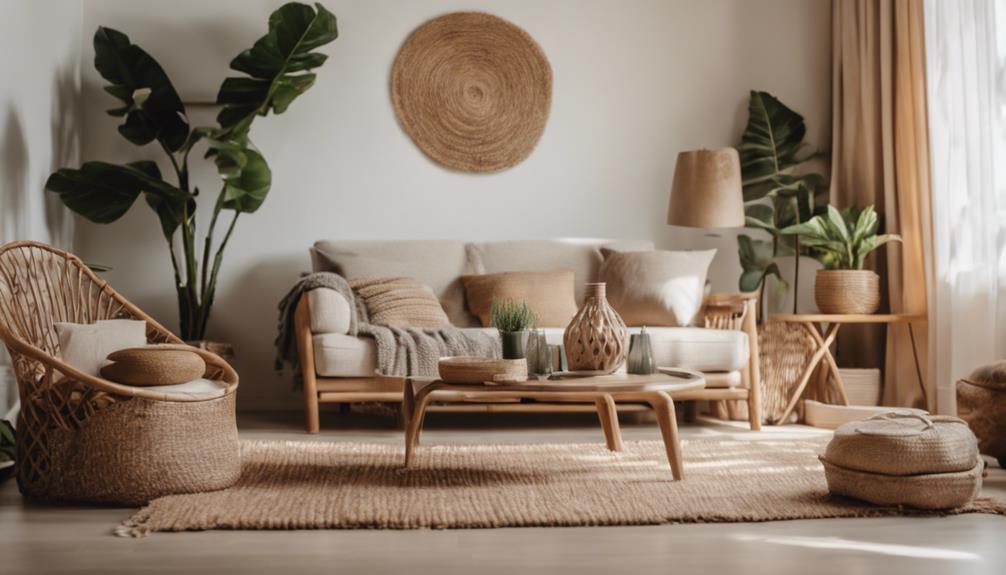To brighten a windowless room, focus on layered lighting like warm-toned bulbs, dimmable fixtures, and strategic placement to eliminate shadows. Choose light, neutral colors and reflective surfaces such as mirrors and glass decor to amplify light. Incorporate various lighting layers—ambient, task, and accent—for flexibility and depth. Add cozy furniture, soft textures, and personal accents to create a warm atmosphere. Explore these tips further to transform your space into an inviting haven.
Key Takeaways
- Incorporate layered, warm-toned artificial lighting with dimmable fixtures to mimic natural light and create a cozy atmosphere.
- Use light, neutral color palettes and reflective surfaces like mirrors to enhance brightness and open up the space.
- Add strategic mirrors and glass decor to bounce light and visually expand the room.
- Combine different lighting layers—ambient, task, and accent—for depth, flexibility, and visual interest.
- Choose soft textures, inviting furniture, and cozy accessories to complement lighting and foster a warm, welcoming environment.
Maximizing Artificial Lighting for Brightness and Warmth

To make windowless rooms feel brighter and warmer, you need to focus on maximizing artificial lighting. Use layered lighting, combining ambient, task, and accent lights to create a welcoming atmosphere. Incorporate warm-toned bulbs to add coziness and eliminate harsh shadows. Natural ventilation can enhance the space’s comfort, preventing stuffiness and supporting overall ambiance. Consider acoustic treatment options that absorb sound and reduce echoes, making the room feel more inviting and less sterile. Proper lighting placement is vital—aim for even distribution to avoid dark corners. Using dimmable fixtures allows you to adjust the mood as needed. Additionally, integrating lighting design principles can further optimize the space’s visual appeal and functionality. By thoughtfully integrating artificial lighting with these elements, you can transform a windowless space into a bright, warm, and comfortable environment.
Choosing the Right Color Palette to Enhance Space

Selecting the right color palette can dramatically influence how bright and inviting a windowless room feels. Light, neutral colors like whites, creams, and soft pastels reflect artificial light effectively, enhancing the sense of openness. Incorporate natural light strategies by choosing shades that complement your window treatments; for example, if you use blackout curtains, opt for lighter tones to prevent the space from feeling cramped. Bold colors can add warmth and personality, but balance them with reflective surfaces or accents to prevent darkening the room. Avoid heavy, dark hues that absorb light, making the space feel smaller. Instead, aim for a cohesive palette that amplifies brightness, creating a welcoming environment even without natural windows. Utilizing cohesive design elements can further unify the space and maximize the effect of your chosen colors.
Incorporating Reflective Surfaces and Mirrored Decor
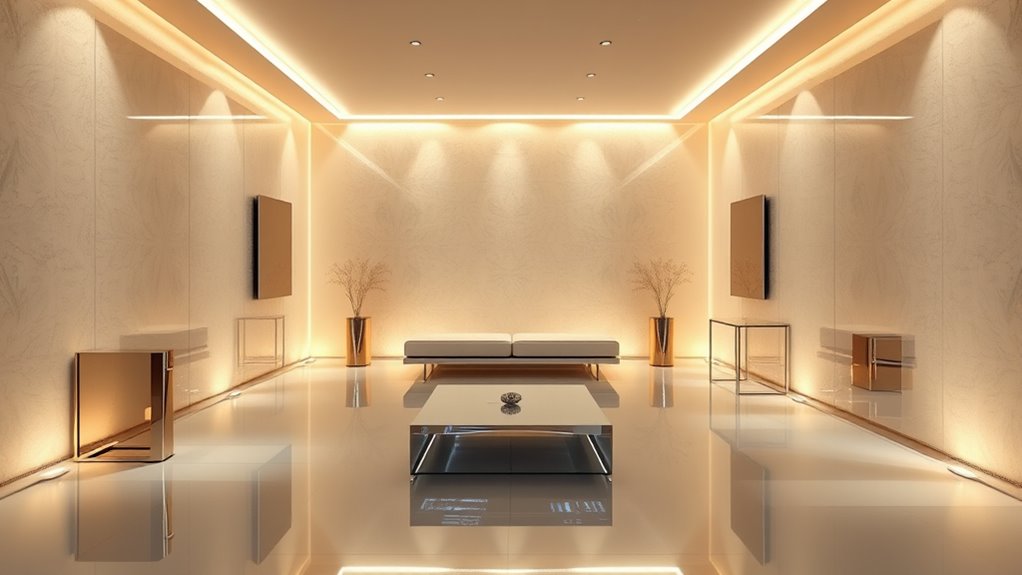
In a windowless room, incorporating reflective surfaces and mirrored decor can make a significant difference by bouncing light around the space. Mirrored wall panels are an excellent choice to amplify brightness, creating an illusion of openness. Glass decor accents, like vases or tabletop pieces, add subtle reflections that enhance the overall ambiance. To maximize the effect, consider these strategies:
Reflective surfaces and mirrored decor can transform a windowless room by bouncing light and creating a sense of openness.
- Use mirrored wall panels as focal points to reflect light and expand the room visually
- Incorporate glass decor accents on shelves or tables for added sparkle
- Mix different reflective surfaces for depth and interest
- Position mirrors strategically to direct light toward darker corners
Using Layered Lighting Techniques for Depth and Flexibility
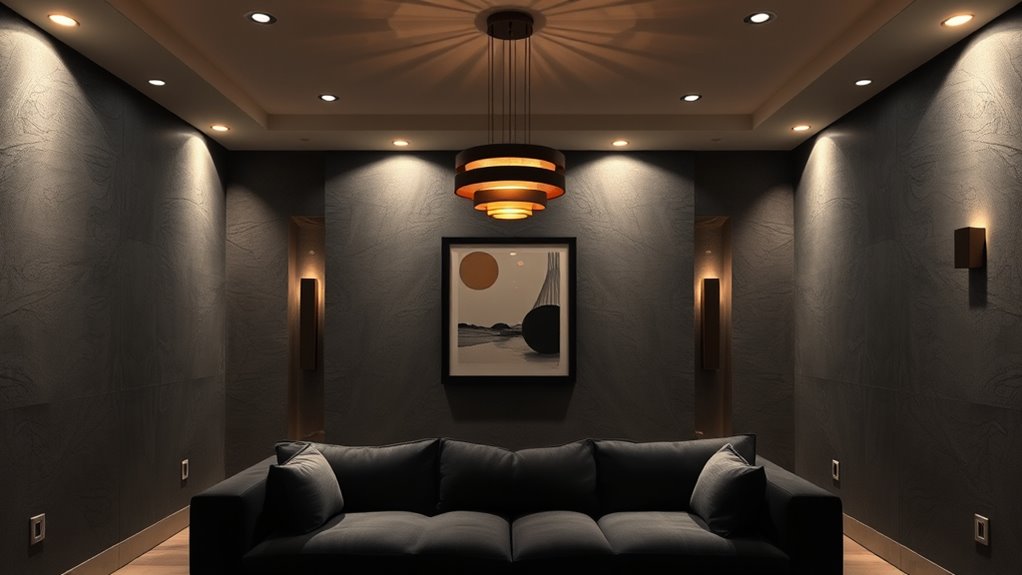
You can create a more dynamic space by mixing ambient and task lighting to add depth and control. Incorporating accent and decorative lights highlights specific features and adds visual interest. Balancing these layers gives your windowless room both flexibility and a welcoming atmosphere. Additionally, utilizing layered lighting techniques allows for easy adjustment of mood and functionality throughout the day.
Combining Ambient and Task Lighting
Layered lighting combines ambient and task lighting to create a versatile and inviting environment in windowless rooms. It allows you to tailor lighting levels for different activities while enhancing depth and flexibility. To achieve this, consider the following:
- Use soft, diffused ambient lighting to mimic natural ventilation and reduce harsh shadows.
- Add focused task lights near work areas or reading spots for better visibility.
- Choose adjustable fixtures to modify light intensity based on time of day or mood.
- Incorporate window treatments that diffuse light or block glare, complementing your layered setup.
- Incorporating lighting controls such as dimmers and smart switches can further customize your lighting experience for different occasions.
Balancing these layers prevents the room from feeling flat or overly bright. Proper layering makes the space feel more dynamic and functional, even without natural light sources.
Incorporating Accent and Decorative Lights
To add visual interest and a sense of personality to your windowless room, incorporating accent and decorative lights is essential. Dimmable fixtures allow you to adjust the lighting intensity, creating mood and highlighting specific areas. Use LED strips along shelves, behind artwork, or along architectural features to add subtle, layered illumination. These strips are versatile and easy to install, offering a sleek, modern look that enhances the room’s depth. Accent lighting draws attention to focal points and adds dimension, making the space feel more dynamic. Decorative fixtures, like statement sconces or pendant lights, can serve as visual anchors. Combining these layered lighting techniques helps you craft a versatile, inviting atmosphere that prevents the room from feeling flat or monotonous. Additionally, considering the color temperature of your lighting can significantly impact the ambiance and overall visual comfort of the space.
Selecting Furniture and Accessories to Create a Cozy Atmosphere
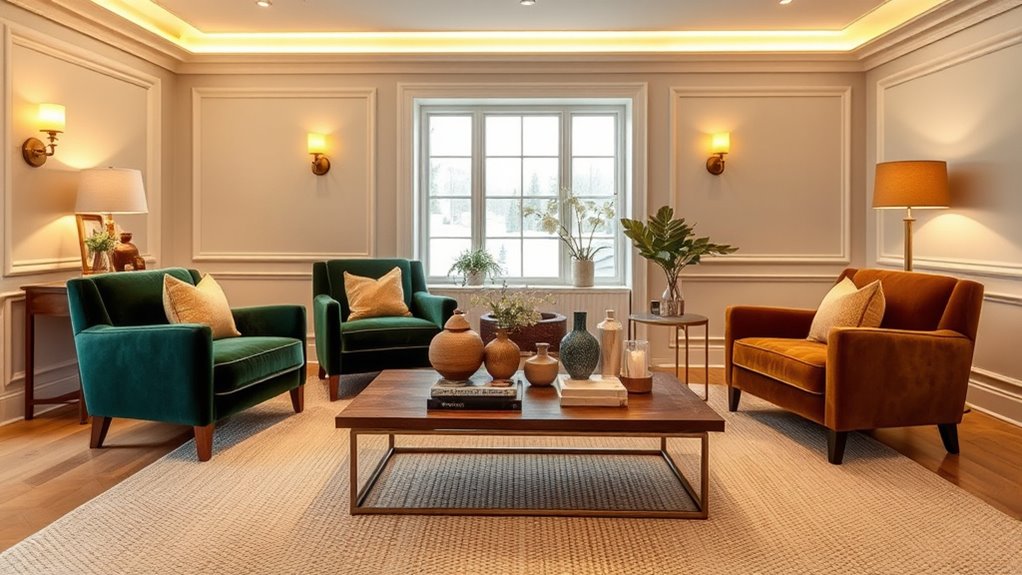
Creating a cozy atmosphere in a windowless room hinges on choosing the right furniture and accessories that foster warmth and comfort. To achieve this, opt for soft textures and inviting pieces. Consider adding floor cushions for relaxed seating and layered throws for extra warmth. Wall art can bring personality and visual interest, breaking up plain walls and adding color or texture. Incorporate warm-toned rugs to anchor the space, and select furniture with rounded edges to promote a welcoming feel. Keep clutter minimal to ensure the room feels open yet snug. Combining soft lighting with these elements enhances the cozy ambiance, making the space inviting and comfortable without relying on natural light. Additionally, selecting appropriate lighting solutions such as warm LED bulbs or adjustable lamps can significantly boost the room’s inviting atmosphere.
Creative Decor Ideas to Add Personality and Visual Interest
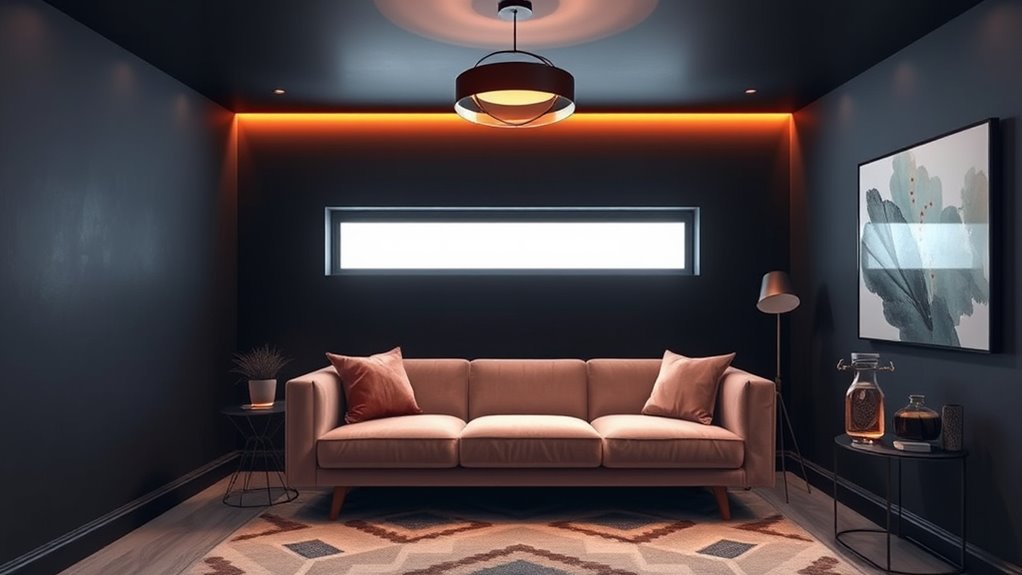
Adding personality and visual interest to a windowless room can transform it from a bland space into a captivating retreat. One effective way is to incorporate artistic wall murals that serve as bold focal points, creating depth and character. Choose murals with vibrant colors or intriguing patterns to bring energy and personality into the space. Additionally, vintage decorative accents like antique mirrors, ornate picture frames, or retro vases can add a layer of charm and nostalgia. These elements not only enhance the decor but also make the room feel more personalized and inviting. Mixing modern pieces with vintage accents creates a curated look that reflects your style. Remember, bold art and thoughtfully selected vintage details can turn a dull, windowless room into a lively, visually engaging haven. Incorporating state-specific decor laws can also help you select appropriate and stylish decorative items that align with local guidelines.
Frequently Asked Questions
How Can I Prevent My Windowless Room From Feeling Claustrophobic?
To prevent your windowless room from feeling claustrophobic, focus on creating a sense of openness. Use natural light alternatives like bright LED bulbs and mirrors to reflect light and make the space feel larger. Incorporate color psychology by choosing light, airy colors such as blues or pastels, which promote calmness and openness. Add plants or artwork to add personality and depth, making your space feel inviting and less confined.
What Are the Best Plants for Low-Light, Windowless Spaces?
You might think low-light plants can’t thrive indoors, but many indoor greenery options do well without sunlight. Popular low light plants include snake plants, pothos, and ZZ plants, which are known for their resilience. Scientific studies confirm these plants adapt to low-light conditions, making them ideal for windowless spaces. Incorporate these greenery choices to add life and freshness, transforming your room into a vibrant, inviting area despite the lack of natural light.
How Do I Balance Lighting to Avoid Glare and Shadows?
You should carefully plan your lighting placement to minimize glare and shadows. Use diffuse light sources, like soft LED fixtures, and position them evenly around the room. Incorporate multiple layers of lighting—ambient, task, and accent—to achieve balanced illumination. Adjust fixture angles and heights to control shadow castings, ensuring no harsh glare or dark corners. This approach creates a comfortable, well-lit environment without unwanted shadows or glare.
What Mood Lighting Options Work Best for Small, Windowless Rooms?
Think of your small, windowless room as a cozy cave that needs just the right glow. Opt for warm color temperature lighting to create inviting warmth, and choose fixtures with dimming options to adjust the ambiance easily. Soft, layered lighting makes the space feel larger and more welcoming, while avoiding harsh brightness. This combination transforms your room into a comforting retreat, perfect for relaxing or working without feeling cramped or gloomy.
How Can I Make a Windowless Room Appear Larger Visually?
To make your windowless room appear larger, use mirror illusions to reflect light and create depth. Opt for light color schemes like whites, pastels, or neutrals that bounce light around the space. Keep decor minimal and avoid heavy furniture. Strategic placement of mirrors and light hues tricks the eye into perceiving more space, making the room feel open and airy.
Conclusion
As you experiment with these strategies, imagine stepping into a room where light dances off reflective surfaces, warmth radiates from carefully chosen colors, and cozy furniture beckons you to relax. Each element works together, transforming the space into a haven that feels alive and inviting — even without windows. But the true magic lies in your next move. Will your design reveal its secrets, or leave you still craving that perfect, luminous finishing touch?





